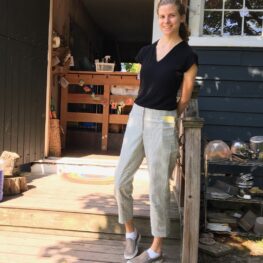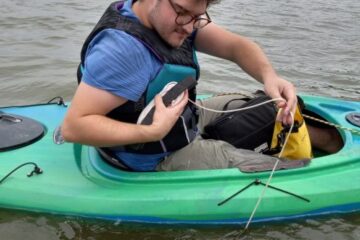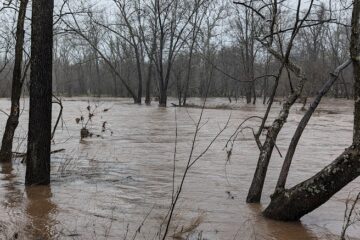 I’m sitting where I have been now for hours, at my family’s front window inches away from a newborn deer on the other side. She was born just today but can already move into the shade to regulate her body temperature, can navigate stones and mulch and the varying textures her feet fall upon. How is she already so much a part of this world she’s viewing for the first time? Of course, I know it’s instinct kicking in- instinct pulling her up by invisible strings and having her try. It’s instinct that I relate to, that I’ve learned to recognize in myself, that keeps me watching. It’s this innate impulse that moves us and that we grow to understand. Our bodies are made to learn. So, on this couch at the front window just an arm’s length and a glass pane away from this wonderful baby, I sit in the perfect space to reflect upon the recently concluded Spring Nature Days, and all the children I met in their own unique stages of life and learning.
I’m sitting where I have been now for hours, at my family’s front window inches away from a newborn deer on the other side. She was born just today but can already move into the shade to regulate her body temperature, can navigate stones and mulch and the varying textures her feet fall upon. How is she already so much a part of this world she’s viewing for the first time? Of course, I know it’s instinct kicking in- instinct pulling her up by invisible strings and having her try. It’s instinct that I relate to, that I’ve learned to recognize in myself, that keeps me watching. It’s this innate impulse that moves us and that we grow to understand. Our bodies are made to learn. So, on this couch at the front window just an arm’s length and a glass pane away from this wonderful baby, I sit in the perfect space to reflect upon the recently concluded Spring Nature Days, and all the children I met in their own unique stages of life and learning.
As much as we, as educators and caretakers, can take credit for the growth of children, we also recognize children themselves as the leaders of their own discoveries. No child arrives a blank slate. Babies are born with the tools needed to connect with parents, often their first and closest circle of community. Other community connections emerge at varying stages, with children constantly developing the skills of cooperative interaction over time. Whether our students spent the past year socializing in smaller class sizes or in a more isolated COVID-19 lockdown at home, each came to us at an important time in their individual journey. I hope that Fairview Farm provided each what they needed to grow their world a little bigger.
My co-educator, Alison, and I had the privilege of creating the first “school” experience for some little ones who had never been in an organized group setting. At three or four, these little explorers were so ready for the interactions awaiting them. They were new to this place, but they searched for familiarity everywhere. Getting to know and teach them required that we honor the selves that they presented- and whatever experiences, knowledge and interests they brought along with them.
From the start, a few children expressed themselves using special objects brought from home: dolls, family photographs, favorite books. During snack time near the middle of our 5-week spring session, one girl, instead of pulling out her cereal, uncovered a bright, thick board book from her backpack. I still smile recalling that instead of asking an adult to read it, she stood confidently reciting the words that she had memorized from repeated readings at home. I would have asked her to eat snack with the other children, but I could not interrupt the moment once I realized what was occurring. Each of her six or seven classmates was fully engaged in her words, their eyes following the reader as she twirled and held the book high above her head to show the illustration the way she’d seen teachers do. The moment was taken over by a little girl’s impulse to imitate what she had witnessed, and include her own story in the community she was still in the process of understanding.
That night, I ordered used copies of other books from the series we had started, thanks to our twirling read-aloud performer, and in the following weeks, we studied the series through play and recitation. I am still thankful that the reader was comfortable enough to assert her voice and experiment with the role she played in a group still somewhat new to her. She and her classmates, in their own ways, were learning that they were a part of something bigger. And I was learning to embrace the spontaneity of their realizations.
Just a few years older than the youngest, the students in our middle age group (ages five to eight) experimented to develop more complex ideas of community. The process of understanding, however, was mostly the same, involving organic interaction, imitation and imaginative play. Early on, in the beloved Fairy Wood, a play world was imagined which the students returned to almost every week after. The story that emerged was of evil trees capturing all sorts of adult animals and leaving their babies orphaned in the wild. Some of the younger children in the group would enact the baby animals while the older few gravitated toward the rescuer role of the fairies. The children were drawn to themes that scared them- the loss of parents, aloneness- but also a sense of healing and justice. They were understanding connectedness.
Now, wouldn’t this group of children love to sit where I am now, watching a deer just hours old toddle on new legs even closer to the window I’m watching from? Children are so easily captivated by animals, not to mention a peach-fuzzy newborn mammal. I believe that in their emergence into a larger community, children understand that they are no longer just to be cared for, but also to care for others. As the community expands, the child is no longer the youngest. There are others with increasingly diverse sets of needs and abilities. Perhaps this is what children realize when they reenact the baby animal stories, when one child playing a polar bear cub leaves its family to go and help a wolf pup stuck in a tree root. An hour later, the game may have ended but the child who played polar bear might perform the nurturing role when someone else falls and feels hurt. The child developed a skill, and play was once again the lesson.
When I began the Nature Days program with our education team, I was full of questions. How do we raise environmentalists? How do children grow into adults who care? Play provided the answer: they already did. The students I’ve been privileged to know have demonstrated their innate need for connection and understanding. From the three-year-old simply growing her sense of self, to the five-year-old switching from victim to rescuer in a game of “bad trees,” to the eight-year-old using his more adaptive play skills to act as mediator to younger players, our nature students are developing themes of environmental justice in ways that make sense and have deep meaning for each of their particular stages of development. We all care about the communities that care for us; children only need adult guidance to understand their changing roles within them. Innately, children, with their strongest impulses and messiest feelings, just fit. It’s our job to remind them of that.
The deer outside my window nibbles grass. Too young to eat anything but her mother’s milk, she is experimenting with her environment, imitating her mother’s grazing. She is understanding that there is change ahead of her. She is playing, and therefore, she is growing.



